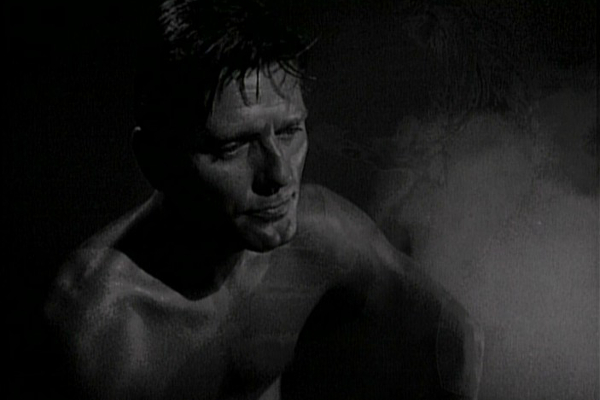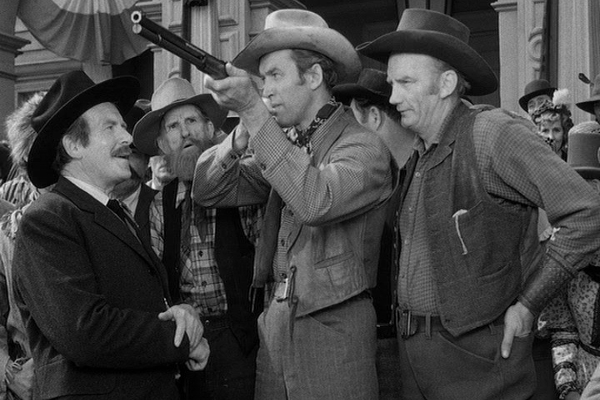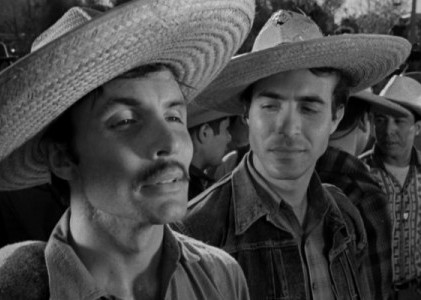Going to Extremes
Museum of the Moving Image is presenting the eight-film retrospective Anthony Mann: Mean Streets and Open Spaces from April 19-27, 2014, in conjunction with the release of Max Alvarez's book The Crime Films of Anthony Mann.
A traveler halts his journey to survey the residue of a massacre in the opening scene of The Man from Laramie (1955). Charred wreckage, shattered wagon wheels and bits of uniforms lie scattered across the stained black earth where a cavalry patrol was wiped out by Apaches. Violence is quite literally part of the landscape in Mann's westerns, which imbue the physical contours of the West with distinct psychological meaning. In the five superb westerns he made with James Stewart between 1950 and 1955, Mann brought out noir strains that had always lurked in the genre, showing that the frontier offers no place for fresh starts, but merely magnifies the conflicts, hatreds, and grievances that men bring into it.
The opening of The Man from Laramie, in which Stewart's Will Lockhart broods over the grim spot where his brother was killed, is the purest enactment of a primal scene that underlies all these stories: an experience of betrayal or loss that festers unhealed. In each film, Stewart plays a man obsessed with righting some irreversible wrong, and the futility of his goals brings a burned-out bitterness to his ultimate triumphs. As he does in Hitchcock's Vertigo, Stewart brings to the Mann films a tormented zeal to restore the past: a warped mirror of the boyish optimism that buoyed his pre-War heroes. Jim Kitses, in his book Horizons West, describes Mann's heroes well, as "dark, extreme men trapped in an impossible dilemma, making a neurotic attempt to escape themselves and rise above a past of pain and violence."
In some ways, Anthony Mann is easy to peg as a filmmaker. His career falls into clear stages defined by genres—B crime dramas in the 1940s, A westerns in the 1950s, historical epics in the 1960s—and is marked by repeated motifs and themes like revenge, flamboyant violence, and doppelgangers. But while his films may seem easy to classify and analyze, Mann remains on a deeper level hard to know as a director. This is partly because so little has been known about him as a person. In his new book, The Crime Films of Anthony Mann, Max Alvarez dispels the vague and unreliable information that has previously been published, revealing fascinating biographical background on the director, who was born Emile Anton Bundsmann in San Diego in 1906. This background includes his childhood in Lomaland, a Theosophical commune in California where he grew up, separated from his parents between the ages of three to thirteen; and his years on the New York stage, as an actor, production manager, and director, including work for the left-wing Federal Theater Project in the 1930s.
Alvarez devotes careful attention to Mann's lesser-known early films (many of which the director himself dismissed), and the series he has curated at the Museum of the Moving Image offers an important chance to see eight of the director's best works screen in 35mm prints. So much of the meaning and value of Mann's films lies in their visual qualities that it can fairly be said they must be seen in a theater to be fully appreciated; only then can the reticent and mysterious Mann be fully appreciated as one of greatest visual storytellers in Hollywood.
T-Men
I. Writing with Light: The Policiers
Anthony Mann first made his mark with a series of low-budget crime movies in a style often labeled semi-documentary—an inadequate if not misleading description of movies that are split between contradictory, even antagonistic styles. The popularity of documentary elements in Hollywood films (omniscient voice-over narration, real locations, fact-based stories, and a tireless interest in procedural minutiae) was a legacy of World War II. Wartime documentaries made by filmmakers like John Ford, William Wyler, and Frank Capra gave audiences a taste for the muscular, factual, authoritative style, which Hollywood then borrowed to lend heft to its crime dramas. The paradox is that this movement overlapped with film noir, but the two styles were drastically opposed. Nothing could be further from the reassuring, stentorian documentary mode, in which every detail is explained and the overpowering might of authority—police, government, technology, science—is continually reaffirmed, than the mode of film noir, which not only depicts but provokes anxiety, confusion, unease, and ambivalence.
This contrast is so stark as to be funny in the opening of T-Men (1947), a seminal film that was Anthony Mann's first collaboration with cinematographer John Alton, his first major commercial success, and the first film he considered his own. "T-Men" are Treasury agents, and the film opens, like so many of the semi-documentaries, with a lecture from a real-life authority figure, Elmer Lincoln Irey, a U.S. Treasury Department Official, seated at a desk in a well-lit office in Washington. Then, as narrator Reed Hadley begins to recount a case in which two T-men went undercover to pursue a gang of counterfeiters, the film plunges us into a dark, brutal, and intensely stylized urban nightmare. Shadowy figures skulk around a maze of low-lit alleys under the looming skeleton of gas-tanks, ambushing and shooting dead an undercover agent. Then it's back to the March of Time narration and a flat-lit meeting in a government conference room.
As these two styles alternate throughout the film, it's hard not to draw certain conclusions. First, that the documentary trappings and glorification of authority are being used as an excuse to revel in the violent, seedy criminal milieu, the way gangster movies of the early 1930s tacked on fulsome public-service warnings to appease the censors. And, second, that Mann and Alton are conniving to demonstrate just how much can be done to enliven a simple cops-and-robbers procedural through lighting, composition, camera angles, and the accentuation of violence.
T-Men, He Walked by Night (1948), and Border Incident (1949) are not strictly film noir, because they lack elements of psychology or interiority, and they are too black-and-white in their division of good and evil—their morality as high-contrast as their lighting—lacking ambiguity or fluidity of identity. If He Walked by Night delved into the mind and past of its sociopathic lone killer; if T-Men showed one of its heroes to be corruptible; if Border Incident gave one of its vicious bad guys some shading of guilt or redemption, they would be noir. That would not necessarily make them better movies, and in the wake of World War II people had reason to know that unambiguous evil, inhumanity, and fascist violence were not just Hollywood simplifications.
These films largely observe their characters from the outside, focusing on surfaces—but what surfaces! Light and shadow provide the depth and complexity lacking from the characters as written; conventional scenes are framed in radical ways. Alton, celebrated for his ability to create maximum drama with minimum resources, titled his book on cinematography Painting with Light, but what Mann is doing in collaboration with Alton is telling stories with light—a little light and a lot of shadow. Nearly every frame of Border Incident, the last and best of the three policiers, is a ravishing work of art, with lighting that recalls not Rembrandt but the sharp, sublime violence of Caravaggio.
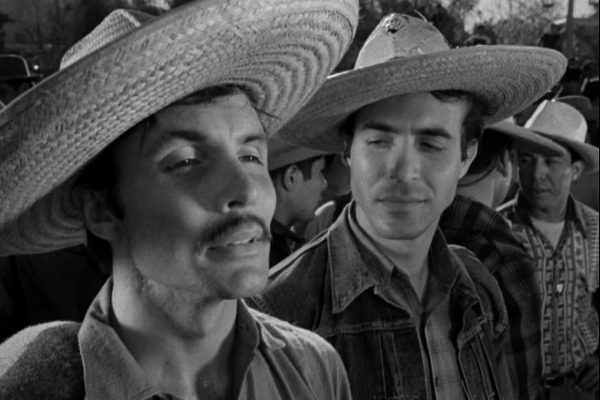
Border Incident
The lighting of faces in particular goes against the grain of Hollywood's usual smooth, flattering style. Partial lighting from below or from some oblique angle gives faces a strong topography of shadow, at times grotesque in classic horror-movie style, at others just dramatic and textured. (Alton could prettify when he wanted to, giving almost cloying diamond-sparkles to the eyes of Raw Deal's women, and a painterly richness to Ricardo Montalban's beauty in Border Incident.) A favorite technique, which appears in the opening of T-Men and repeatedly in He Walked by Night, has a face emerging from blackness, revealed like the moon as the darkness moves across it. Many scenes use back-lighting that turns people into silhouettes and carves out deep spaces around them, spaces often given even more volume and dimension through steam, smoke or mist. The steam bath sequences of T-Men are a flamboyant tour-de-force: hazy, dreamy, with glistening bodies melting in and out of focus. (Dissatisfied with the amount of steam supplied by a real sauna, Mann and Alton brought in dry ice, leaving star Dennis O'Keefe with frost-bitten toes.) Even more beautiful are the scenes in He Walked by Night where the killer flees into the Los Angeles storm drains. Flashlights and watery reflections play over the concrete tunnels, their surfaces shimmering with water and clouded with mist and tear gas. Unaccompanied by music, the chase sequence is pure abstract art.
By all accounts, Mann as a director did little to shape the performances in his films, despite his own background as an actor. His later films gained immeasurably from the passion of stars like James Stewart, Robert Ryan, and Barbara Stanwyck. His early crime movies relied on the competence of less exalted professionals like O'Keefe and the always wonderful Claire Trevor; the flavor provided by veteran character actors like Wallace Ford and Howard Da Silva; and the reliable nastiness of heavies like Charles McGraw and Raymond Burr. When actors were miscast or simply poor, Mann seems to have done little but work around them. What he did do was to frame actors in compositions that convey a great deal of information while also creating a strong mood. Rather than isolate actors in typical shot-reverse shot close-ups, he often kept two or three, or even more, together in the frame; actors are often placed in the extreme foreground against detailed backgrounds, or shot from startlingly high or low angles. The visual impact of Mann's compositions makes the voice-over narration in movies like T-Men and He Walked by Night even more unnecessary and distracting.
Mann spoke of looking for "pictorial stories" that would lend themselves to this kind of visual exposition. He regularly worked with certain screenwriters, including John C. Higgins, who wrote or co-wrote T-Men, He Walked by Night, Border Incident, and Raw Deal; Borden Chase, and Philip Yordan. Mann's films are replete with symmetry, and though they almost never revolve around a love story, they are filled with pairs: partners (the agents in T-Men and Border Incident), rivals (the two women in Raw Deal, the two sons in The Man from Laramie), and doppelganger enemies (in Winchester '73, the hero and his villainous brother compete in a shooting contest, displaying identical skill). In most cases, one of the pair dies or is defeated: the Manichean sense of conflict lends itself to resolutions through elimination rather than union.
Perhaps this is one reason why death scenes stand out so prominently in Mann's films. The emotional climax of T-Men comes when one of the two undercover agents, O'Brien (Dennis O'Keefe), has to watch as his partner, Gennaro (Alfred Ryder), is unmasked and killed by the gang they've infiltrated; he dies protecting O'Brien by taunting him as a sucker. It's a harrowing scene, but not even the most memorable death in T-Men. That belongs to the movie's most colorful character, the Schemer (Wallace Ford), a conceited, pathetic, on-the-skids crook addicted to steam baths and Chinese health herbs. His death is a prime example of Mann's fondness for turning the benign to deadly use, a motif that goes back to his first film, Dr. Broadway (1942), in which a character is fried under a tanning lamp. Using light or steam to kill seems slyly self-referential: these are cinematic deaths, almost death by cinematography.
Border Incident was conceived as a kind of sequel, "T-Men on the Border," but made after Mann's move to MGM. It's a better film in part because there are fewer intrusions of narration and government-office procedure, but primarily because the trafficking of illegal immigrants is a far more vicious crime than counterfeiting greenbacks. (A low point in T-Men comes when a Treasury investigator condescendingly chides a Farmer's Market vendor for accepting a phony ten.) Exposing the savage exploitation of Mexican braceros who enter the United States illegally, Border Incident is strikingly contemporary; the fact that audiences always laugh at the end, when a narrator cheerfully informs us that the problem of illegal immigration is now a thing of the past, is a depressing reflection on this relevance. We see how farm-workers impatient with waiting for permits to enter the U.S. are loaded into trucks with false bottoms, lying side by side like the cargo of slave ships, covered with dappled light sifting through the hay piled over them. The film is full of such simultaneously gorgeous and horrific images.
Border Incident looks forward to the westerns Mann would begin making the following year. It opens like a western, with a pack of bandits robbing and killing three migrants in a jagged canyon. Alton's images of the desert at night are astonishing: every rock and shrub, dust-storm and barbed-wire fence is picked out clearly, yet there is a total sense of emptiness and desolation under huge skies raked with thin clouds. The western landscape, as harsh and indifferent as the men who inhabit it, suits Mann's vision of human extremity and isolation better than the stylized urban labyrinths of his other crime movies. The gruesome means of murder in Border Incident are singularly fitting: an immigration agent is killed with a mechanical reaper, and the braceros are disposed of in quicksand. The earth literally swallows them, an ironic death for men who work the land, bringing food out of the soil, only to be destroyed by the machinery of profit-driven agriculture.
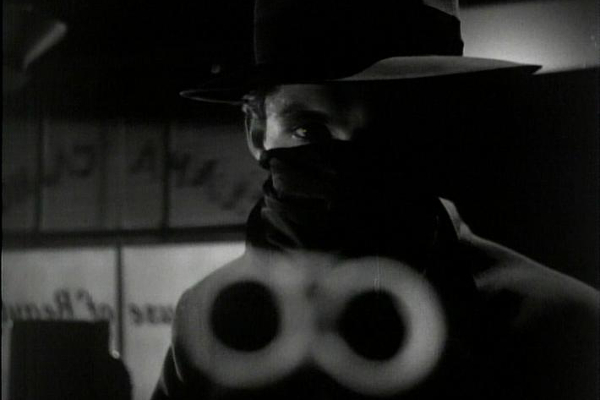
Raw Deal
II. Bullets and Caresses: The Noirs
Raw Deal (1948), Mann's noir masterpiece, packs extraordinary complexity and range into a compact, tautly constructed story. Like Out of the Past (1947), it moves through different settings fitfully as a troubled dreamer: a prison, a woman's bedroom at night, a mountain road, a towering old-growth forest, a windswept beach, a taxidermy store, a hotel room, a ship's cabin, a fog-blinded alley, a burning room. Whether indoors or outdoors, locked up or running, in the wilderness or the city, the characters remain hemmed in, constrained by their own emotions as much as by the forces of law and crime.
At the center and turning point of the movie is an interlude in the woods, a series of scenes that have a Grimm's fairy-tale quality. Joe Sullivan (Dennis O'Keefe), on the lam after escaping from jail, stops to rest in his flight with two female companions: Pat (Claire Trevor), his loyal girlfriend, and Ann (Marsha Hunt), their hostage. The triangle is a complicated and ever-shifting one: there is a strong attraction between Joe and Ann, though she disapproves of his law-breaking and violence, and he sneeringly calls her "Miss Law and Order." Pat is jealous, knowing Joe is not in love with her but merely grateful because she helped him escape; though heartsick, she accepts her lot and understands that Joe wants the decency that Ann represents. This is far from the standard good girl-bad girl dynamic common noir; both women are sympathetic, and the perspective we share on the situation is not Joe's, but Pat's: she narrates portions of the film in a melancholy, beneath-the-breath reverie underscored by the haunted drone of a theramin.
As the three sit around a campfire, Joe revels in the fresh air, the freedom he broke out of jail to find. When the rustle of a chipmunk makes him jump, Ann taunts him that he'll never be free while he's on the run—and as if on cue a park ranger approaches. While Joe retreats behind a tree with his gun drawn, the ranger chides the two women for their fire, and Ann makes a special effort to distract and appease him. But afterward, she insists she did it not to protect Joe but to save the young ranger: "You would have killed him! I saw your face. I may have romanticized you before, but now I know: you're something from under a rock." This bitter confrontation festers between them, only resolved finally when Ann shoots Fantail (John Ireland), a thug sent to get rid of Joe, and realizes she too is capable of panicked violence.
But first comes a scene that is unconnected to the movie's plot yet central to its pained, compassionate vision. The trio is at a backwoods hideout waiting for a car to continue their journey, when the place is surrounded by a swarm of police with dogs and heavy artillery. Joe's first thought is that Ann has betrayed him, but it turns out the cops are hunting someone else, a man who "went psycho" and killed his wife. When the terrified, breathless killer pounds on the door begging to be let in, it is Ann who takes pity on him: Joe sides with her mute appeal while Pat urges him not to take the risk of discovery. Once inside, the tormented murderer (played by ubiquitous character actor Whit Bissell) pants that he doesn't know why he killed his wife, that he doesn't want to live without her, that he deserves to die. He runs out firing in the air and is felled by the police guns. The impact of this strange, sad, hallucinatory episode lies in the way it brings Ann and Joe together in a bond of unselfish decency. Pat sees this connection, but she doesn't wrestle with it herself until the end of the film, when she has to choose whether to give up her chance to escape with Joe in order to save Ann. The script's honesty doesn't falter: Pat's decision doesn't turn on her conscience but on her realization that even if Joe marries her, it will always be Ann he loves.
True to Mann's pictorial method of storytelling, the dynamics of this love triangle are diagrammed in striking compositions: Pat and Joe, after a quarrel, sitting apart on a bed with their backs to the camera; Joe and Ann huddling in the dark with shadows of pine trees drifting over their faces; Pat and Ann passing each other on a stretch of deserted road by the beach, as they trade cars and places. It is the inner conflicts and unstable identities of these characters that give the film its pure noir heart. These same elements appear in Mann's other noir entries like The Great Flamarion (1945) and Side Street (1950), based on classic premises of deception, temptation, terrible mistakes, and unraveling lives.
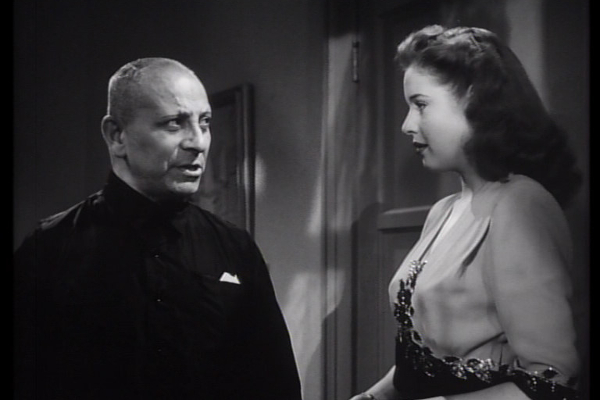
The Great Flamarion
The Great Flamarion does not seem to have been a happy experience for either Mann or his star Erich von Stroheim, but it is a neglected delight. Stroheim understandably chafed at playing yet another crazed egotist on the skids in a B movie, yet another role unkindly alluding to his own downfall. He objected to the film's flashback format, not appreciating that the noir fatalism of a story narrated by a dying man bypasses traditional what-happens-next suspense. (In fact, very few of Mann's films unfold in flashback.) But though he may have been a pain to direct, Stroheim is magnificent as the vaudeville sharp-shooter Flamarion, an embittered loner seduced by a heartless beauty who wants him to kill her husband. Connie (Mary Beth Hughes) and Al (Dan Duryea) are Flamarion's stooges in an act that has him discovering his wife with another man and shooting up the stage, blasting a glass out of his assistant's hand, lighting her cigarette with a bullet, and shooting off her garter and the shoulder strap of her dress. Flinging herself shamelessly at the austere, repressed gunman, Connie tells him how the act thrills her: "Every bullet is a caress!"
Obsessively practicing with mechanical targets in his hotel room, clad in black satin pajamas, Stroheim does remarkable acting with the back of his head, the fat neck and shaved scalp at once menacing and poignantly vulnerable. Soon he's acting like a besotted schoolboy, and the scene where he waltzes alone around a flower-filled bridal suite, waiting for Connie who will stand him up, is excruciating. He never recovers from the realization of how he's been duped and used, becoming a shabby, scruffy bum as he searches for the woman who double-crossed him. A close-up of Stroheim's dark, pain-filled eyes leaps from the screen, too real for this brisk, snappy entertainment. Dan Duryea adds another dose of pathos in a riveting performance as the drunken, clinging husband Connie talks Flamarion into murdering. What Mann brings to the film is an expressive yet concise and never-dallying style far removed from Stroheim's own compulsive, novelistic verisimilitude.
Because Mann's visual style is so emphatic and dynamically expressive, there can be a sense of overkill when it is applied to a simple story, especially when it's overlaid with redundant explanatory voice-over. Side Street follows the basic, fool-proof noir formula of an average guy who gives in to a momentary weakness and spirals into a bottomless nightmare. The story's case study quality is accentuated by trite voice-overs and generic, albeit great-looking, footage of New York. Though it starts off like a carbon copy of The Naked City, Side Street focuses on a hapless one-time thief rather than on the detectives pursuing him, making it a more gripping and emotional film. In almost every scene, however, the images are more powerful than the rather clichéd script, which tends to nudge characters towards caricature, and tells us what the hero, Joe Norson (Farley Granger), is feeling. This is completely unnecessary, since Granger's face throughout is a map of terror and panicked guilt, the face of a hunted animal that hears the baying of hounds.
Norson is in every way an average Joe: an ex-serviceman who has lost his business and struggles to support his pregnant wife as a menial temporary mailman. His dreams are standard issue: he wants to buy his wife a mink coat and take her to Paris. His mistake is to snatch a folder from an office on his mail route, thinking it contains two hundred dollars; instead it holds $30,000, a blackmail payoff. Joe's is possibly the world's most imperfect crime, and throughout the film he bumbles like a hopeless amateur. But no one else does much better, since everyone connected with the blackmail scheme and the cover-up is eliminated by the scarily single-minded George Garsell (James Craig.)
Perhaps the most disturbing character of all is Harriet (Jean Hagen), George's former girlfriend, whom Joe tracks down near the end of his trail, singing in a Greenwich Village dive. The scene where Joe squeamishly flirts with the drunken songbird, desperately trying to get George's address out of her, is riveting-though even here, Hagen's dumb-broad patter doesn't match the beautiful shots of their two sad, strained faces floating in blackness, as though they were the only two souls in a dark universe. When Harriet gets wise that Joe is trying to track down George, she sets him up; her abject fawning over her brutish ex-boyfriend is repaid when he throttles her while they kiss in the back of a taxi-one of the quickest but cruelest Mann deaths.
The climactic car chase through empty canyons of the financial district at dawn is, like the chase through the sewers in He Walked by Night, so abstractly beautiful that it inspires detached awe more than nail-biting suspense. But Cathy O'Donnell, in the largely thankless role of Joe's sweet, innocent wife, wrings every drop of anguish out of her few big moments: when the police force her to talk on the phone to Joe while they track the call, she lunges forward with a strangled scream: "Run, Joe, run!"; and the final scene where she runs to throw herself on his body as he lies on a stretcher replays the conclusion of They Live by Night, released the previous year. But this time, the narrator returns and reassures us that he's going to be all right, weakening the film's final moments. As with Border Incident, the comforting voice-over is undermined by Mann's understanding of the weight and consequences and intractability of violence.
Winchester '73
III. Unhealed Landscapes: The Westerns
This intractability becomes the great theme of Mann's westerns, a suite of past-haunted stories that wrestle with vengeance and redemption. Revenge drives James Stewart's character to some degree in every one of the five westerns he made with Anthony Mann, most centrally in the first, Winchester '73 (1950), and the last, The Man from Laramie. The circumstances vary from the most straightforward quest—in Winchester '73, Stewart's Lin McAdam doggedly hunts down his no-good brother, who killed their father—to the most oblique and perverse scheme: in The Naked Spur (1953), Stewart's Howard Kemp tracks a killer with a price on his head in order to buy back the ranch he lost because of a faithless woman.
A hugely entertaining picaresque, Winchester '73 weaves Lin McAdam's search into a lively tapestry of the Old West. Wyatt Earp presides over Dodge City on the Fourth of July; a cavalry troupe anxiously waits for an attack by a tribe eager to repeat the recent victory at Little Bighorn; a woman whose cowardly husband abandoned her during an Indian raid winds up sparring with an affable but trigger-happy bandit (Dan Duryea, bringing all his smirking, slithery charm to the role of Waco Johnny Dean). All these episodes are strung together by the title object, a perfect gun that passes from hand to hand; it's like La Ronde with death taking the place of sex. The Winchester is both a magical object of desire—every man who sees it is instantly smitten and determined to possess it—and a curse, since every man who claims it dies soon after. For men of the West, guns are both indispensable equipment, almost part of their organic makeup, and expressions of identity. In Dodge City, where Wyatt Earp makes every man coming into town check his firearms (what would the NRA think?), Lin and his brother spot each other and comically clutch at their empty holsters.
Winchester '73 is a more conventional western than its successors, and Lin McAdam—tough but gallant, with a warm twinkle in his eye—is less of a departure from Jimmy Stewart's pre-War persona than the wounded, irascible, hard-bitten characters he would play in The Naked Spur and The Far Country (1955). But he starts to give hints of the obsessiveness and the brittle, vindictive rage that would fuel these darker portrayals. In each of the Mann-Stewart westerns, something in Stewart's past hangs over him, unresolved and ticking like a bomb.
The climax of Winchester '73 introduces a classic Mann motif: when Lin finally catches up with his brother, Dutch Henry (Stephen McNally), their confrontation is not a clean, ritualistic shoot-out on an emptied Main Street. Instead they fight to the death on a vertiginous crag of rock, using boulders for cover as they maneuver for a position from which to take fatal aim. This kind of rugged, precipitous landscape of ledges, crags, fortresses of rock recurs in The Furies (1950), The Naked Spur, and The Man from Laramie. It is a perfect setting for Mann's characters, whose psyches never lie smooth, but are shaped by violent breaks and eruptions. It is a landscape where people cannot coexist, where there is only room for one survivor.
The historical or legendary elements that decorate Winchester '73 are rare in Mann's westerns; he is not interested in how the West was won so much as in how the landscapes of the West—their dwarfing vastness, their arid harshness, their majesty and indifference—affect the psychological convolutions of stories rooted in universal sources of suffering. With their tortured family relationships and morally conflicted heroes brooding over old grievances that must be expiated through violence, the westerns draw deeply from Shakespeare and Greek tragedy. In particular, Mann kept returning to King Lear, which he alludes to in The Furies, The Man from Laramie, and his austere masterpiece Man of the West (1958). None of these films closely follows Shakespeare's plot, but all revolve around the volatility and melancholy of powerful men weakened by age, and the greed, infighting, grudges and jealousy that swirl around them.
The Man from Laramie is the richest and most satisfyingly complex evocation of Lear, a stately film that balances the aggressive, violently competitive male world with an unusually strong depiction of a peaceful and civilized female domain. The Lear figure is Alec Waggoman (Donald Crisp), a cattle baron who rules over a vast ranchland and the town of Coronado. His failing eyesight signals his declining powers and also the emotional blindness that leads him to misjudge both his heirs. He ends up sightless, helpless, and heirless, comforted by a woman he long ago cast aside.
The cracks and flaws in Alec's empire are revealed by the arrival of a stranger, Will Lockhart, who is searching for the man who sold repeating rifles to the Apaches who killed his brother. A solitary army man ("I can't rightly say any place is my home...I always feel I belong where I am") who never owned an acre of land or wanted to, Lockhart stands apart from the hunger for land and power and dominance that drives the other men: Alec and his two heirs, biological son Dave Waggoman (Alex Nicol) and foster son Vic Hansbro (Arthur Kennedy). With his curly hair and a plump red face, the unstable Dave looks like a monstrous overgrown baby; he's hysterically determined to prove himself as tough as his father, equating manliness with gratuitous violence. Alec knows his vain, weak son is incapable of running the ranch or staying out of trouble, so he has given the smart, capable Vic the responsability of managing the ranch and being his brother's keeper, promising him an equal share as his inheritance. Alec manipulatively plays the two boys off against each other, letting Vic think he recognizes him as his real son, while assuring Dave that shared blood is more important. He underestimates both how degenerate his true son is, and how far the crafty foster son will go for what he believes are his rights. Arthur Kennedy excelled at ambivalent roles like Vic Hansbro. Blond and sharp-featured, with a smile that twists into a snarl, he has a shrewdness often soured by spite, an easy friendliness that covers moral weakness and opportunism. His best performances were often as men twisted by resentment of their secondary status, making him a brilliant foil for more self-assured heroes.
Alec Waggoman is domineering and often wrong-headed, but not dishonorable; when he suspects that Dave might be guilty of running guns to the Apache, he threatens to disown him. But the patriarch is responsible for the corruption of his heirs; Vic is warped by his desire for property, while Dave believes he is emulating his father's legendary exploits when he attacks "trespassers," seizes cattle that have wandered over from another ranch, or tries to kill Lockhart, who gave him a mild beating. Will's first encounter with Dave is unforgettable as a nightmare, set against salt flats that look like a vast frozen lake. Lockhart and the men in his wagon train are collecting salt they have been told is free for the taking, when Dave and his posse suddenly ride down on them, accusing them of stealing from Waggoman land. They lasso Will and drag him through the ashes of a campfire, burn his wagons and shoot his mules. The slaughter takes place offscreen, but the animals' screams form a soundtrack to the bonfires burning red against the snowy plain of salt, giving the scene a surreal, phantasmagoric horror, like something from Dante or Goya.
Lockhart's only help comes from women: genteel store-keeper Barbara Waggoman (Cathy O'Donnell), who startles him with an invitation to tea; and Kate Canaday (Aline McMahon), owner of the only rival ranch in the area, who hires Lockhart as her foreman. Kate remains loyal to Alec even though he jilted her to marry Dave's mother, who is blamed for spoiling the boy. Dave commits his ultimate atrocity in a psychotic tantrum of self-pity after Lockhart, firing back in self-defense, nicks his hand. He orders his men to disarm and hold Will while he shoots him point blank in the hand; afterward the men hang their heads or look away in mute shame.
The camera pans quickly from Will's hand to his face as he nearly swoons with shock and agony: eyes rolling, lips drawn back, body crumpling, whimpering shrilly. Close-ups of men's sweaty faces grimacing in anguish are a signature throughout Mann's films, from Richard Basehart operating on his own bullet wound in He Walked by Night to Dennis O'Keefe being tortured by Charles McGraw in T-Men to Gary Cooper with a knife to his throat in Man of the West. This trademark, and his fondness for bizarre, showy methods of murder, leaves Mann open to charges of sadism. (Manny Farber affectionately called him a "tin-can De Sade.") Mann himself said in a 1953 interview, "I'm the most unsadistic guy in the world, personally, but I've done so many westerns and gangsters I don't know how to kill a man any more."
But in his mature films, the violence is admirably unenjoyable. No action movies are more honest about the reality of physical pain, or about the way violence damages the perpetrator as well as the victim. Discussing Men in War, in which soldiers pointlessly spill their blood for a bit of rocky wasteland in Korea, David Thomson pinpoints the realization that "violence must be total if it is to succeed." It is this epiphany that guts Mann's heroes, leaving them emotionally depleted if not dead. In his films, men who enjoy killing—like Dave Waggoman, or the criminal band on Man of the West, or Arthur Kennedy's character in Bend of the River who bares his teeth in wolfish delight whenever he shoots someone—are subhuman beasts. And good men like Will Lockhart, who feel obligated to mete out violent retribution, must confront the fact that there is no clean way to kill. When Lockhart finds out who sold rifles to the Apaches, he raises his gun, saying with relish, "I've come a thousand miles to kill you." But he finds himself unable to pull the trigger, and finally gives up, saying with deflated disgust, "Get away from me."
This could be read as a redemptive happy ending, in which the hero grasps the futility of vengeance and lets go of his hatred. But the moral triumph feels oddly like a defeat, as it does in The Naked Spur, when Kemp can't force himself to sell a man for money, or Man of the West, when Cooper's Link Jones wipes out all remnants of his ugly past. Each of these men carries a psychological wound that drives him to pursue a vengeance he believes will make him whole again. Each must finally face the truth that the past can never be erased or corrected, a truth that leaves them not cleansed but broken. Anthony Mann's best films end with his heroes hollowed out by their experiences, having been pushed to an extremity from which they can never make their way back.
![]()
LATEST ARTICLES
-20140814-173707-thumb3.jpg)
Fighting Words
by Imogen Sara Smith
posted August 12, 2014

Fighting Words, Part 2
by Imogen Sara Smith
posted August 20, 2014

On the Margins: The Fil…
by Andrew Chan
posted August 12, 2014

Robin Williams: A Sense…
by David Schwartz
posted August 12, 2014
 Going to Extremes
Going to Extremes
THE AUTHOR
Imogen Sara Smith is a writer living in Brooklyn. She is the author of two books, In Lonely Places: Film Noir Beyond the City and Buster Keaton: the Persistence of Comedy
More articles by Imogen Sara Smith
